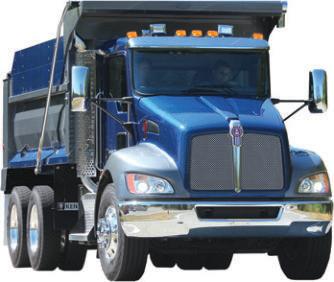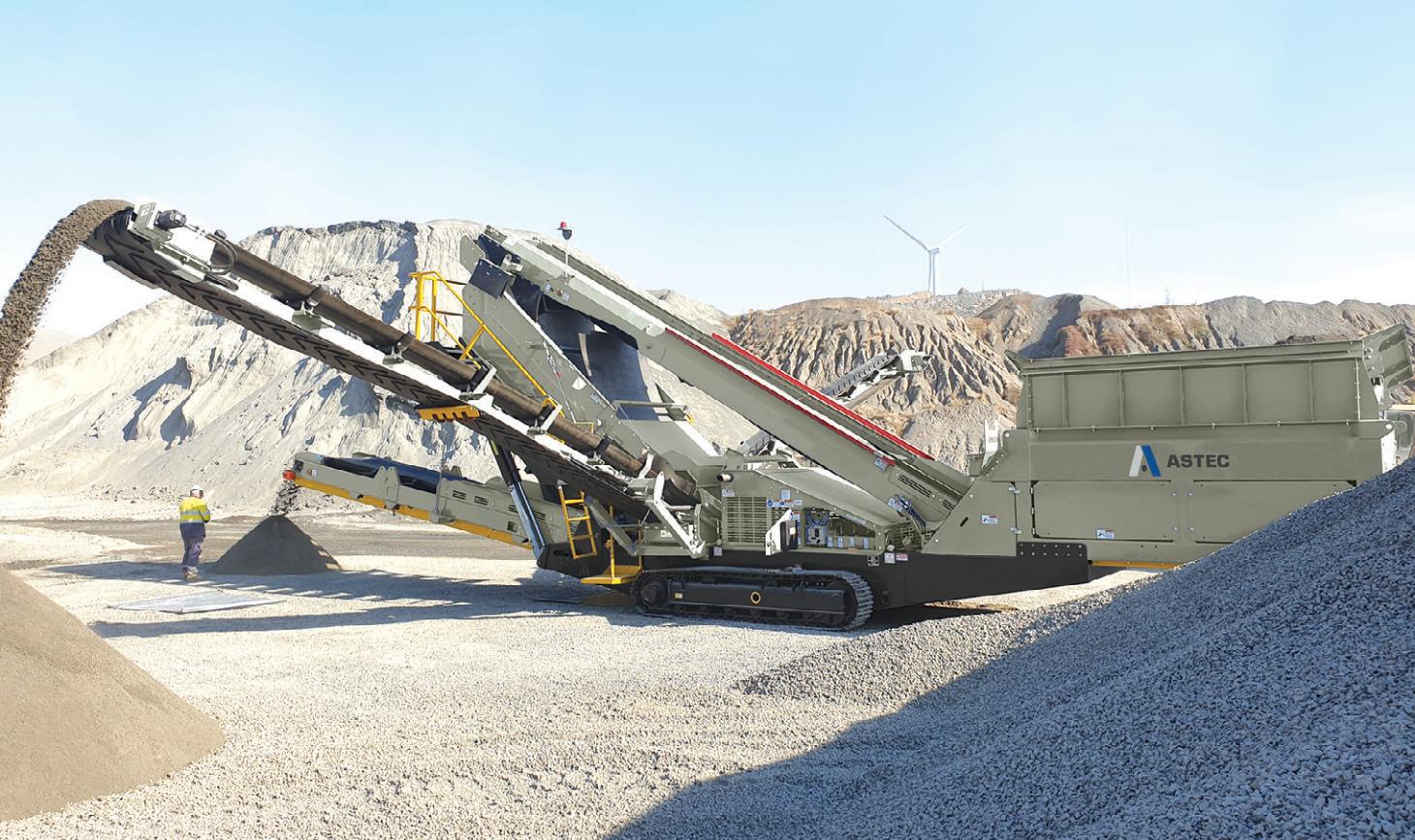
8 minute read
Attachments & Parts Section
Pages 31-37S E C T I O NAttachments & Par ts
For more information about these attachments and more, visit our Attachments Section on our Web site at www.constructionequipmentguide.com

Werk-Brau Celebrates 75 Years With Open House
Visitors were able to tour the more than 500,000-sq.-ft. manufacturing campus complex, see displays of Werk-Brau products and the equipment they are used with, and enjoy barbecue, refreshments, ice-cream, prize drawings and more. Additional activities for younger visitors included bounce-houses, pony rides and a train ride.

Werk-Brau Co. Inc., a manufacturer of buckets and attachments for excavators and loaders, celebrated its 75th anniversary with an open house for employees and their families, retirees, customers, suppliers and colleagues, and the community on Aug. 27.
Visitors were able to tour the more than 500,000 sq. ft. manufacturing campus complex, see displays of Werk-Brau products and the equipment they are used with, and enjoy barbecue, refreshments, ice-cream, prize drawings and more. Additional activities for younger visitors included bouncehouses, pony rides and a train ride. Nearly 1,000 people attended the event, which ran from 10 a.m. to 2 p.m.
“We’re humbled and thankful that so many people chose to celebrate with us,” said Jon Ballinger, Werk-Brau president. “People make this company what it is, and we’ve been blessed with wonderful, dedicated employees over the years. It was great to host not only our current employees and their families, but many retirees and their families, as well as those within the Findlay community.”
The core vision upon which Werk-Brau was founded still drives them today, “safely provide excellence in quality, design and delivery of products and services which exceed our customers’ expectations.” It has grown from a single blacksmith shop to numerous North American locations with 500,000 sq. ft. of manufacturing space and more than 500 employees. It maintains dealer direct partnerships with more than 2,000 North American heavy equipment dealers from its Findlay, Ohio, headquarters.
One aspect of the business that has changed dramatically is technology, which is helping customers to be more efficient, productive and safe on their job sites. Werk-Brau supplies hydraulic D-LOCK couplers, tilt-rotator couplers, hydraulic thumbs and a wide range of other specialty tools and construction attachments to assist in these efforts.
Technology also plays a much larger role in heavy equipment manufacturing than it did seven decades ago. Werk-Brau combines modern manufacturing technology such as robotics and high-definition plasma cutting, together with old-world craftsmanship into each bucket, thumb, coupler and attachment it manufactures. Its goals today are the same as they were when Duke Werkheiser and Dutch Brautigam opened their blacksmith shop in 1947, to provide excellence in customer service and exceed customer expectations.
Werk-Brau manufactures a complete line of OEM and replacement attachments for excavators, mini excavators, backhoes, mini and full-size loaders, and crawler loaders.
For more information, call 800/537-9561 or visit www.Werk-Brau.com.

DEMAND from page 1 corporate optimism expressed by other construction companies across the United States.
“Demand for both new and used equipment continues to be at high levels and sales backlogs remain at record levels,” said Ryan Greenawalt, chairman and CEO. “Our organic physical rental fleet utilization and rates on rental equipment continue to improve and tightness of supply continues to buy inventory values across all asset classes.”
He attributed the rosy picture to “industry tailwinds” from the passing of the Bipartisan Infrastructure Bill, saying it is driving further demand for construction machinery.
“In our material handling segment, labor tightness and inflation are driving the adoption of more advanced and automated solutions while also driving the market to record levels,” said Greenawalt.
Multiple Factors at Play
The U.S. construction equipment market specifically is experiencing a high compound annual growth rate (CAGR) because of increased building activities for infrastructure development.
That is the conclusion of a study conducted by India-based market research firm BlueWeave Consulting.
“The U.S. construction market is estimated to grow at a CAGR of 6 percent during the forecast period of 2022-2028,” researchers reported. “The growing demand for construction equipment in this region is fueled by increased construction activities for infrastructural development as a result of government and private investment.”
Because of this considerable investment, the infrastructure segment of the construction equipment market holds the biggest market share, said BlueWeave.
In fact, “explosive” is how one industry legal expert terms the global growth in demand for heavy machinery.
He attributes the explosion to economic and geopolitical developments.
Chief among industries seeing a significant uptick in machinery demand is the mining sector, said attorney James. R. Waite.
The uptick is driven by demand for lithium, graphene, cobalt, nickel and other components for batteries, electric vehicles and clean technologies, he said.
“Further bolstering the mining industry is increased demand for precious metals and traditional commodities, especially in Latin America, Asia and Africa,” Waite said in an article in Engineering News Record. “In construction, demand for equipment and parts continues to skyrocket as countries around the world begin a new push to update roads, bridges and other infrastructure.”
But, he said, upgrades are especially pressing in the United States, where roads, bridges, rail and other infrastructure projects are finally starting to receive significant government funding.
“That will directly benefit the heavy equipment industry, but it also will see logistical issues mount and supply shortages become more acute,” said Waite.
He predicts the war in Ukraine and sanctions against Russia will drive up energy costs in the United States and elsewhere.
What the Future Holds
Waite also predicts regional consolidation specifically in the southeastern United States, where the state of Georgia is gaining a reputation as global hub for innovation in construction equipment.
“Six of the world’s top 10 equipment manufacturers have identified the state as the new Silicon Valley of equipment manufacturing,” said the heavy equipment industry attorney. “Georgia’s business-friendly climate and a host of strong structural advantages have provided a strong boost to manufacturing and the heavy equipment industry in particular.”
Georgia provides significant tax breaks for manufacturers and job creators, augmented by a generous state R&D tax credit.
The state also offers a skilled labor force, low rates of unionization, a top-tier university and technical college system, a superb manufacturing infrastructure and a worldclass transportation system, he said.
Despite global issues including inflation, rising interest rates and the war in Ukraine, the heavy equipment sector is among industries continuing to make headway.
Waite said the industry has successfully leveraged global economic, infrastructure and geopolitical conditions to considerable advantage.
“As a result,” he believes, “the industry is poised to continue thriving for the foreseeable future, driven by demand in multiple, only partly overlapping, industries, including mining, construction, energy and agriculture. States that seek to attract more heavy industry should follow Georgia’s businessfriendly example.”
Market’s Cautious Optimism
Early this year, the Association of Equipment Manufacturers (AEM) weighed in on the construction equipment market’s expansion, saying that a number of challenges could present obstacles.
Short-term factors such as the lingering pandemic, ongoing supply-chain issues and persistent labor shortages were chief among AEM’s list of challenges.
Secondary to those issues that have emerged to dampen enthusiasm were deglobalization and inflation.
“The last recession we experienced ended the longest period of economic expansion in the United States, and that recession lasted from February 2020 to April 2020,” said Benjamin Duyck, AEM director of market intelligence.
“Two months, in traditional economic terms, can’t even be accurately described as a recession,” he said. “However, this economic disruption has impacted us all greatly, and we are still dealing with the aftereffects today — labor shortages, supply chain problems and higher interest rates.”
The responses to AEM quarterly member surveys for the past two years have been positive in regard to how quickly they expect to recover to pre-COVID-19 levels.
“But the data for this last quarter is moving again in the other direction, largely due to the headwinds we’re facing with inflation, workforce issues and supply chain disruptions,” said Duyck.
Though inflation is a little lower, it has risen gradually, with a 9.7 percent increase in the last quarter of 2021.
Talent acquisition also is a troublesome factor for both ag and construction equipment manufacturers.
AEM’s most recent quarterly member survey found that hiring remains a major issue.
In fact, 84 percent of all respondents have experienced issues in this area, while 90 percent of all ag members surveyed are affected.
Members are strategic in addressing hiring challenges, incorporating internships, educational partnerships, higher wages, bonuses, marketing and recruitment efforts, flexible hours and outsourcing.
But the association believes workforce will remain a prevalent issue for equipment manufacturers for the foreseeable future.
Supply-chain problems plaguing ag and construction equipment manufacturers also remain a major issue.
“COVID-19, followed by growing numbers of employees leaving the workforce, have led to both shutdowns and scarcity of products,” he added.
In response, the supply chain has adjusted production downward to meet expected lower demand.
Plus, there’s the fact that shipping companies cut schedules, expecting a drop in demand for shipments.
And though demand in some aspects of the economy dropped, the decrease was not evenly spread over all industries and all workers, AEM noted.
“While people still continued to spend money on homes and consumer purchases, interest rates remained low, and the U.S. experienced an expansion in monetary supply,” said the association. “Furthermore, workers and businesses were supported by the government. All of this, combined with the scarcity of products and higher demand results in inflation, adversely impacting supply chains.
An eventual scarcity of products coupled with higher demand resulted in inflation making its way up the supply chain.
At the same time, factories could not expand easily due to bottlenecks in the chain

An uptick in machinery demand in the mining sector is driven by demand for lithium, graphene, cobalt, nickel and other components for batteries, electric vehicles and clean technologies.



